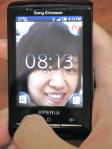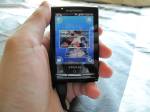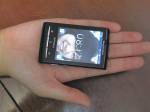Mention ‘Smartphone’ and the products that come to mind are hand-sized devices about the size of your hand. Most weigh in excess of 180 grams. Most will show a bulge when placed inside your front jeans pocket, and I’d be very concerned about putting them on the back pocket.
The Sony Ericsson (SE) breaks this Smartphone tradition by coming in at a miniscule 83 x 50 x 16 mm. In fact the closest Smartphone rival of comparable capability is the larger and HTC Wildfire (106.8 x 60.4 x 12 mm).
Using the X10 mini can take getting used to. The UXP interface is an acquired taste (but don’t let my hesitation fool you, it doesn’t really take that much time to learn how to use the phone and most of its features).
WHAT I LIKE
In my view, four things combined to make this worth buying: (1) Android + UXP; (2) battery life in a small package; (3) reasonably good camera; and (4) size.
If you are a little overwhelmed by HTC Sense, you will likely appreciate the simplicity and capability of the UXP (UX platform). On the HTC Sense you can add widgets on each of seven home screens. But this is only possible because the phone’s display (say HTC Wildfire) is large enough to hold more than one widget. On the SE x10 mini, this is impossible given the 2.5″ (diagonal) display. But SE conceded this limitation by allowing you to post one widget on any of the 20 home pages. The one app per page actually minimizes the clutter I often find distressing as you start using the phone more frequently.
A phone of this size that supports 3G, GSM and Wi-Fi would surely conk out the battery even before eight hours is gone. SE continues its traditional of good battery life per charge with the X10 mini. I get about two days worth of calls, SMSes, emails via Wi-Fi, a few hours of music and one episode of a favorite TV series. The screen may look ridiculously small at 2.5″ but mind you I managed to comfortably watch a movie on the phone whilst I traverse the MTR stations in Hong Kong. No, I didn’t stay in the MTR station for the entire length of the movie. Instead I continue what I was watching each time I ride the train. All the HTC Android phones I tested don’t remember where I stopped the movie before stepping out of the train. As I result, I avoided using the phone. Yey, SE!
The SE X10 mini comes with a 5MP camera. I’ve tested the cameras on the HTC Desire, HTC Wildfire, and BlackBerry 8900, and I can tell you the X10 mini’s 5MP is a great little camera for taking shots outdoors. The photos are nice and crisp. You can’t this kind of quality from the other phones equipped with similar camera configs. SE also added a video light feature when you want to take videos with the phone.
While I carry a backpack everyday to work, I usually keep my phone in the front pocket of my jeans (left or right). With my trusty old BlackBerry 8900, its almost impossible to get the phone in, much less out of my jeans (I usually hold my breath and tuck my tummy in as I attempt to pull out the phone out of my pocket). The HTC Desire was just as tight. The HTC Wildfire was a little kinder to my pocket. The X10 mini fits in there and I can still cram a headset or a pack of tissue.
WHAT I DON’T LIKE
If there is anything to be learned from the Apple iPhone series is that simplicity of use is very important. Owners of Windows-based PCs, digital video cameras, digital cameras and DVD recorders don’t read the user manual that comes with their device. So it was for me that when I got the X10 mini to try out, I discovered that this is a complicated product to use. In fact I had to download the user manual from the Sony Ericsson website in order to learn enough about the phone to make practical use of it, like navigating using the UXP. Of course, once you get past the nuisances of the interface, everything else becomes simple.
Google Nexus One owners have likely upgraded to Android 2.1 or 2.2 by now. Some HTC phones are shipping with Android 2.1 with a few already earmarked for a 2.2 upgrade. Unfortunately for the X10 and X10 mini series, upgrade to 2.1 won’t come until the last quarter of 2010 (and likely it will be in the December timeframe). http://blogs.sonyericsson.com/products/2010/05/05/sony-ericsson-xperia%E2%84%A2-x10-to-get-uxp-upgrade-in-q4-2010/
I am not altogether sure why but after a week’s use I started to notice a lag when using the X10 mini. Whether its trying to switch on the phone to make a call, or send an SMS, or read my email, I notice a lag of a couple of seconds before the phone switches to the app I want to use. This is particularly annoying because Sony Ericsson has added a sensor that detects if the phone is next to your face, indicating that you making a call. What happens is the phone screen blanks out. I understand this is to make sure that you don’t accidentally press a button while on the phone. But if you need to quickly press a button (say if you are on an IVR call), the time it takes for the screen to come back up is very annoying).
MY FINAL THOUGHTS
I’m a long time SE handset customer for many years from my favorite T91 to my P810 and P900. I loved those phones. They worked as advertised and almost all cases I only have to take out the charger twice a week. This is a big difference compared to my wife’s experience with her Nokia phone. She’s a die hard Nokia customer despite the fact that (1) the Symbian interface lacks intelligence; and (2) the phones simply leak battery power big time.
Would I trade my BlackBerry 8900 for an X10 mini? Probably not! Why? I text a lot. I also read and respond to my emails on my BB. Nothing beats a physical keyboard for this kind of job.
I will be testing the X10 mini pro after this. Who knows? I just might change my mind.
Other reviews:
TechRadar
Pocket-Lint.com
Engadget
ITPro
Metro
Technical Spec
Sony Ericsson
Network: quad band GSM, 3G
Data: GPRS, EDGE, 3G, WLAN, Bluetooth, USB
Dimension: 83 x 50 x 16 mm
Weight: 88 g
Display: 240 x 320 pixel, 2.55 inch capacitative screen
Internal storage: 128MB
Camera: 5MP with VGA video @30 fps, video light and geo-tagging
OS: Android 1.6
CPU: Qualcomm MSM7227 600 MHz
External storage: microSD up to 16GB
Completer spec here: http://www.gsmarena.com/sony_ericsson_xperia_x10_mini-3125.php








